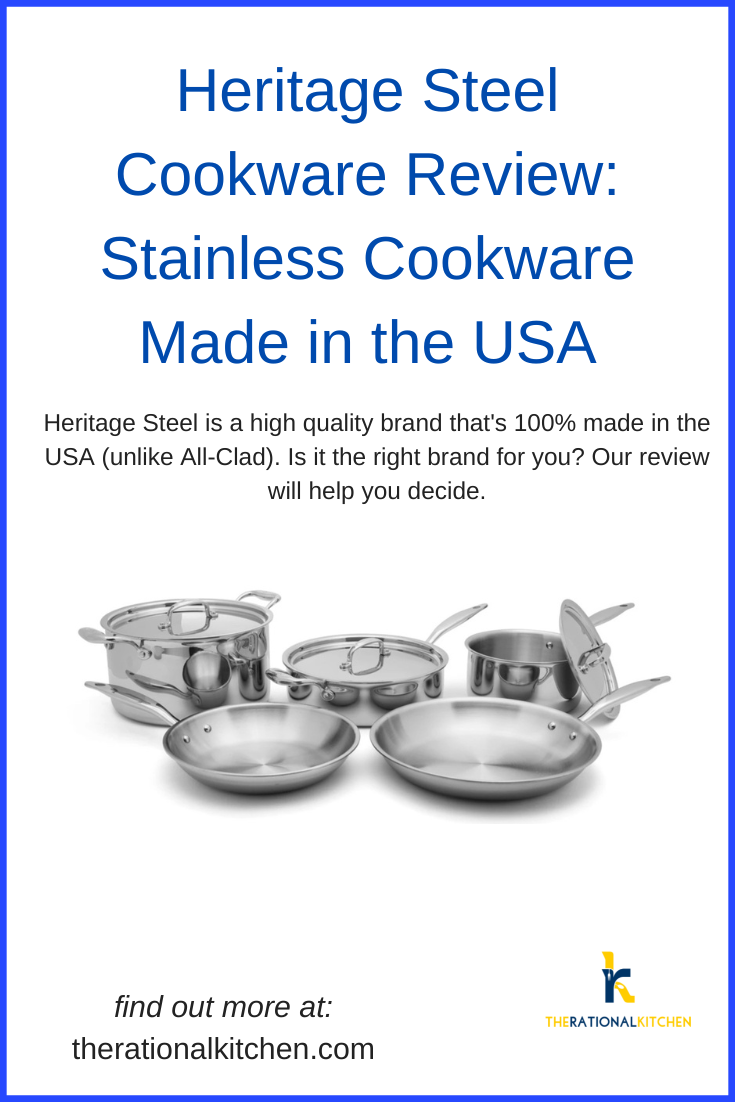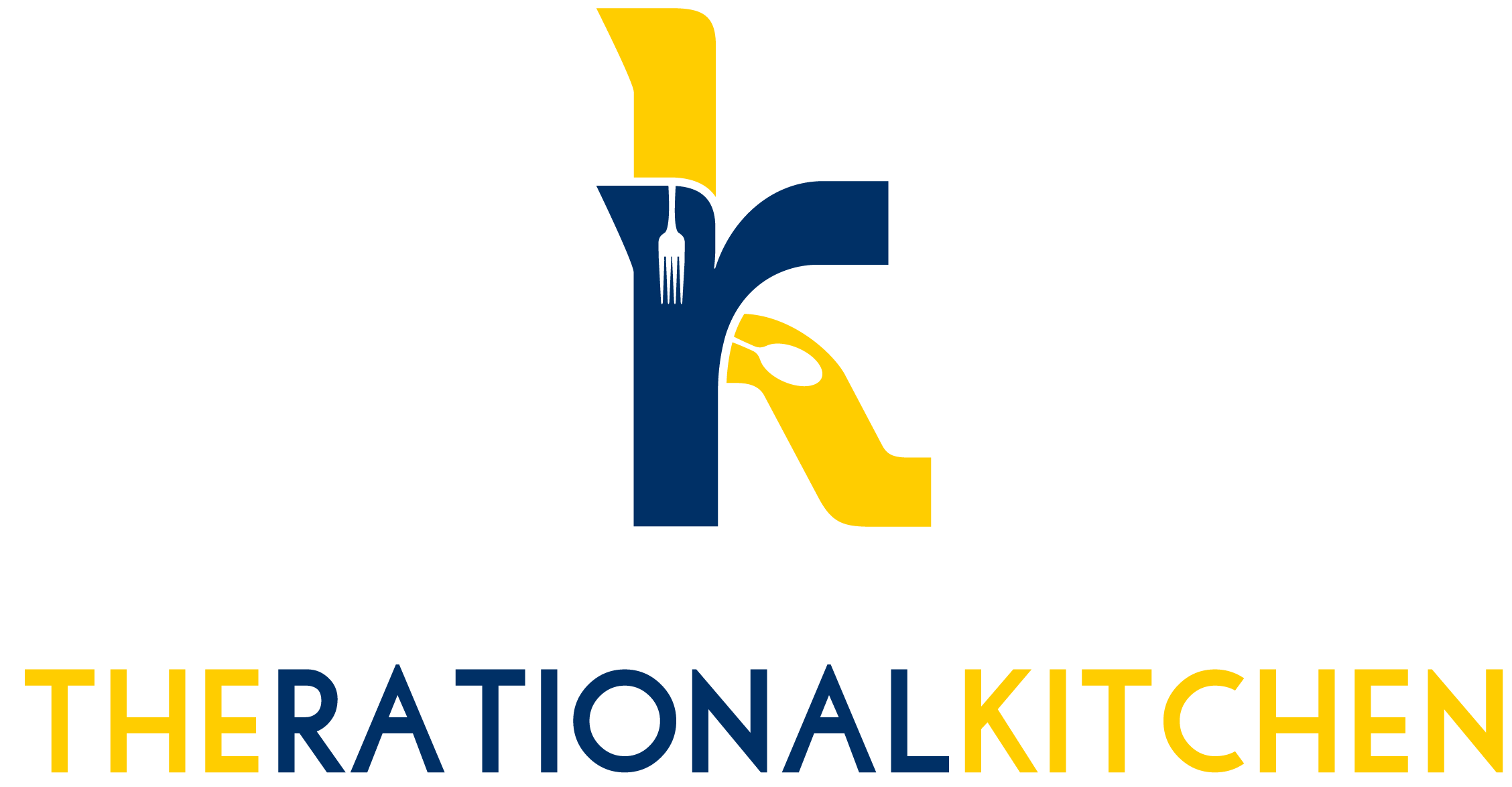Heritage Steel cookware is an American-made cookware brand that isn't as well known as All-Clad, but has some impressive features, including 5 plies and a cookware surface made from 316Ti stainless steel (like Saladmaster, but considerably less expensive). Their newer Eater line has a 304 stainless cooking surface (like All-Clad) and is less expensive, but still high quality.
This Heritage Steel Cookware review takes a look at the brand, including features, history, pros and cons, and more. We also compare Heritage Steel to other well known cookware brands like All-Clad, Made In, and Saladmaster. Find out if Heritage Steel is a good fit for your kitchen.
Our Heritage Steel Recommendation
Heritage Steel is excellent quality cookware completely made in the USA. The prices run similar to All-Clad and the lifetime warranty ensures these pans will last just as long. The sets have good pieces (especially the 8 piece sets) and the cookware is a pleasure to use. Overall, a top quality brand. Highly recommended.
Heritage Steel Cookware at a Glance
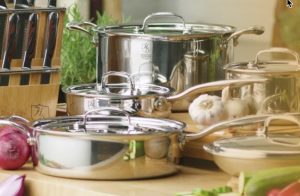
Heritage Steel makes two lines of clad stainless steel cookware, their original Titanium Series and the newer Heritage Steel x Eater Series (they collaborated with the food website Eater for this line). The Titanium Series has several pieces, including skillets, sauce pans, sauciérs, stock pots, woks, rondeaus, deep sauté pans (a versatile piece!), sauteuses, and more. The Eater Series has basic pieces: skillets, sauce pan, sauciér, sauté pan, and stock pot.
Both series are 5-ply with three inner layers of aluminum. The Titanium Series has a 316Ti cooking surface. The Eater Series has a 304 cooking surface (like All-Clad). The Titanium Series has a polished exterior and the Eater Series has a brushed exterior (a popular choice today).
This Heritage Steel review will take a detailed look at both Heritage Steel lines.
Feature | Titanium Series | Eater Series |
|---|---|---|
Construction: | - 316Ti cooking surface (Titanium), - 439 magnetic stainless exterior -Polished exterior - Variable thickness 2.3-2.8mm (due to thickness of heating core). | -304 cooking surface - 439 magnetic stainless exterior -Brushed exterior - Variable thickness 2.3-2.8mm (due to thickness of heating core). |
Lids: | -Stainless, made in USA -Some flat, some domed, depending on piece. | -Stainless, made in USA -Flat |
Nonstick: | Heritage Steel does not make nonstick pans of any type. | Heritage Steel does not make nonstick pans of any type. |
Induction Compatibility: | All Heritage Steel pans are induction compatible. | All Heritage Steel pans are induction compatible. |
Oven Safe to: | 800F | 800F |
Warranty: | All products have a limited lifetime warranty against manufacturing defects. | All products have a limited lifetime warranty against manufacturing defects. |
Made In: | - All pieces and lids are made in the USA, but some raw materials are imported. | - All pieces and lids are made in the USA, but some raw materials are imported. |
- Skillets 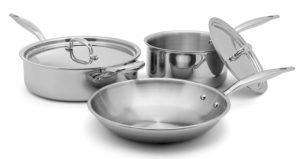 | 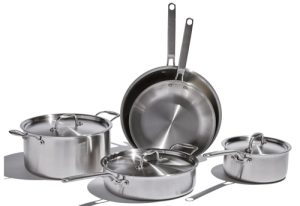 |
About Heritage Steel
Heritage Steel is a family-owned business located in Clarksville, Tennessee. It began as Vollrath's consumer cookware division back in 1974. In 1982, it was purchased by Donald Henn and renamed New Era. The Henns still own New Era today but it has been re-named Heritage Steel. For many years New Era made several brands of cookware, including many brands of waterless cookware. Today, it looks like they're only making Heritage Steel cookware and no longer producing waterless brands, although they still sell replacement parts for them.
New Era developed a number of clad cookware innovations. They introduced one of the first lines of induction cookware in 1985. They developed a 7-ply design in 1987 (top notch cookware, sadly discontinued), and in 1990 they invented the "whistle system" used on many brands of waterless cookware to notify you when food has reached cooking temperature and it's time to turn down the heat.
Heritage Steel acquired the Hammer Stahl cutlery company in 2008 and now makes high quality German steel Hammer Stahl knives.
New Era used the 7-ply design on their Hammer Stahl cookware, introduced to the market in 2013, as well as on many of their waterless brands. Hammer Stahl cookware was phased out a few years ago, and today Heritage Steel's design is 5-ply with three inner layers of aluminum (more on this below).
In 2007, Heritage Steel (still New Era at this point) moved operations to a new facility that is "environmentally friendly and efficient, using a state-of-the-art chemical-free washing system." It's one of the cleanest cookware manufacturing plants in the world.
Heritage Steel clad stainless cookware and Hammer Stahl knives are their main products today.
You can read more about Heritage Steel cookware on their website.
About Clad Stainless Steel Cookware
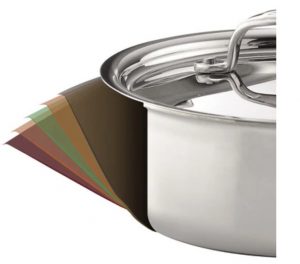
Clad stainless steel cookware has stainless steel on the exterior and cooking surface, with internal layers of aluminum and/or copper. The metals are fused together under great pressure--"clad"--to act as one.
Clad cookware gives you the stability and non-reactivity of stainless steel for the cooking surface, plus the rapid, even heat distribution of aluminum and/or copper.
Most clad cookware has an outer layer of magnetic steel to make the cookware induction compatible. Magnetic steel is used only on the exterior of pans because it is less corrosion resistant than non-magnetic steel.
Clad stainless steel cookware can have as few as three plies--stainless-aluminum-stainless--up to 5 or even 7 plies, with internal layers of aluminum, copper, or more stainless steel.
Also, clad cookware can be fully clad or disc-clad (also called bottom-clad or impact bonded). Full cladding extends throughout the cookware, all the way up the sides, as this Heritage Steel diagram shows:
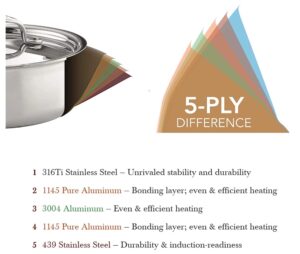
Disc-clad cookware has a clad base welded to stainless steel sides; it has a "seam" around the bottom where the disc meets the sides that makes it easy to spot:
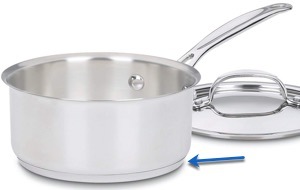
All Heritage Steel cookware has full cladding, so we won't talk more about disc-cladding.
5-ply cookware has become popular in recent years, and many people assume it's automatically better than tri-ply. However, the number of plies isn't nearly as important as the thickness and configuration of the plies. For example, tri-ply cookware that's 3mm thick is going to perform better than 5-ply cookware that's 2.7mm thick (we talk more about this below in the Heating Performance section). And cookware with internal plies of aluminum is going to perform better than cookware with internal layer(s) of stainless steel, with faster, more even heating. (Some people disagree with us on this, but this is what our testing has shown.)
There can be huge discrepancies in quality of clad stainless steel cookware. To buy good quality clad cookware, you need to know:
- The overall thickness (typically 10-20% stainless steel, 80-90% heating core)
- The heating core configuration (heating core layers should be aluminum and/or copper)
- The quality of the stainless steel used (there is a huge difference in quality even among "surgical" stainless steels used in cookware manufacturing).
Overall, clad stainless cookware is considered versatile and durable. It is the choice of most professional chefs and also serious home cooks, especially those who want to avoid the toxins and environmental issues in nonstick cookware.
How Heritage Steel Cookware Is Different from Other Clad Stainless Steel Brands
Heritage Steel cookware has some distinct features that set it apart from other brands of clad stainless steel cookware (including All-Clad).
316Ti and 439 Stainless Steel
The first big difference between the Heritage Steel Titanium Series and most brands of clad stainless cookware (including All-Clad) is the steel they use. Most companies use a 304 grade, either 18/8 or 18/10, for the cooking surface and 409 or 430 magnetic stainless on the exterior for induction compatibility. These are considered excellent quality "surgical" stainless steels and are highly resistant to corrosion.
The Heritage Steel Titanium line uses 316Ti stainless steel for the cooking surface and 439 magnetic stainless on the exterior. Both are considered more corrosion resistant than the standard 304, 409, or 430 used on most other clad stainless cookware brands.
316Ti steel contains titanium and molybdenum, which makes the steel "20 times more resistant to corrosion and pitting from chloride solutions that occur when cooking with salt directly in the pan." In other words, Heritage Steel cookware won't get those salt stains that you see on other stainless steel cookware (little white freckles on the cooking surface).
439 is the highest grade of magnetic stainless steel, also strengthened with titanium. Its corrosion resistance is comparable to 304 stainless steel. This is impressive, and will also result in more durable cookware.
This is not to say that other stainless steel cookware brands aren't resistant to corrosion, because they are. In fact, the new Heritage x Eater cookware uses 304 steel on the cooking surface (and 439 on the exterior). But the Heritage Steel Titanium Series goes the extra mile by using even more corrosion resistant steel than you'll see on most other cookware brands. The only other maker we know of that uses 316Ti is Saladmaster, which costs hundreds (or even thousands) more than the Heritage Steel Titanium.
An important point: Many people think 316Ti steel contains less nickel and chromium than 304 and won't leach. However, 316Ti contains the same amounts of nickel and chromium as 304 stainless, and leaches them at about the same rate. This is a separate issue from corrosion resistance, but is related, particularly if you're concerned about chemicals leaching into your food (although the amounts of chromium and nickel that leach is small, and stainless steel cookware is one of the safest choices you can make).
All Parts Made in the USA
Heritage Steel makes all parts of their cookware in the US, including lids.
All-Clad now makes their lids in China, as well as their nonstick cookware, appliances, and utensils. They even make some of their clad stainless cookware in China now (any All-Clad with disc-cladding is usually made in China).
Being made in China is not necessarily an indicator of poor quality, and there are a few brands of Chinese-made clad stainless we really like. However, it is important to many buyers that they are getting an American-made product. If this is important to you, Heritage Steel is the clear choice over All-Clad.
Unfortunately, it's hard to find products that are 100% American, and Heritage Steel does source some of their materials overseas. We know that they get some of their steel from Korea. This is largely due to supply chain issues and the fact that 5-ply steel is hard to find in the United States. All of our testing shows that the Heritage Steel steel is good quality.
Variable Wall Thickness
Variable wall thickness means that different cookware pieces have different thicknesses. Heritage Steel uses 2.8mm thick clad stainless for their skillets and 2.3mm thick clad stainless for sauce pans, stock pots, and other pieces.
This is great, well-thought-out design, as skillets need that thickness for both durability and performance, and pieces meant for use with liquids do not.
Varied thickness also keeps pieces like sauce pans and sauce lighter, which most people prefer.
You see this variable thickness only in top stainless brands like Demeyere and in high-end copper cookware. All-Clad, as well as most other clad cookware makers, use the same thickness on all of their pieces (it's almost certainly cheaper to use the same steel for everything).
No Nonstick Options
We love this about Heritage Steel: they do not make any nonstick pans.
This is a conscious choice on their part. The designers at Heritage Steel understand that nonstick cookware doesn't last, is terrible for the environment, and maybe most importantly, isn't necessary: you can learn to use any type of pan for eggs and other delicate foods.
You can read more about their non-nonstick philosophy on their website.
Cookware makers that claim to offer a lifetime warranty on all their cookware are being deceptive if they offer nonstick pans. Heritage Steel doesn't want to make pans that don't last, so they don't sell nonstick.
They also offer a wealth of information about how to use stainless steel so it doesn't stick. We have featured much of this information in other articles here on our site.
How to Buy Cookware (The 5 Most Important Features)
If you've read our other articles, you know we include this section in most of our cookware reviews. If you have good information, you're more likely to buy cookware that you will love and which will serve your needs for many years to come.
The important features to consider are heating, durability, safety/stability, design, and value.
Heating
Heating performance is the most important aspect of cookware. This is a complex subject, so much so that many books have been written about it. However, there are just three factors about heating you need to know to buy cookware: thermal conductivity, heat retention, and mass.
Thermal Conductivity
Thermal conductivity refers to how evenly and quickly a pan heats. A pan with good thermal conductivity will have fast, even heat distribution, with minimal hot and cold spots.
Good thermal conductivity also means a pan responds quickly to heat changes.
For most tasks and most cooks, thermal conductivity is the most important aspect of cookware. That is, cooks want cookware that heats evenly and responds quickly to changes in temperature.
Copper and aluminum have high thermal conductivity ratings. Clad cookware lined with a good amount of aluminum and/or copper will also have good thermal conductivity.
Heat Retention/Capacity
Heat retention, also called heat capacity, measures how long a pan hangs onto heat after the heat source is removed. This is especially important for deep frying and high heat searing because temperature crashes mean not getting optimal results.
Cast iron and carbon steel have the highest heat retention of all cookware. They are nearly identical materials, but because cast iron is usually thicker--i.e, it has more mass--it has higher heat retention than carbon steel.
Clad stainless steel cookware has medium heat retention: not as good as aluminum or copper, but better than cast iron and carbon steel. This makes it a versatile choice that's good for most cooking tasks.
Opposites?
Thermal conductivity and heat retention are essentially opposite properties: If a material has good thermal conductivity, it has poor heat retention. If a material has good heat retention, it has poor thermal conductivity.
For example, cast iron, with its excellent heat retention, heats slowly and unevenly, meaning its thermal conductivity isn't great. However, if you give cast iron (or carbon steel) enough time to heat through, the heat evens out and its poor thermal conductivity isn't a big issue and may even be a plus, especially if you're using it for a task that requires heat retention (like searing or deep frying).
Conversely, aluminum and copper are both quite responsive to changes in temperature, which means they have poor heat retention.
However: If a copper or aluminum (or clad ) pan has enough mass, it will have good heat retention, in some cases enough to compete with cast iron (such as the Demeyere Proline skillet, with almost 4mm of aluminum).
No, copper and aluminum won't have the heat retention of cast iron, but if the pans are thick and heavy, they will have enough that they'll hold onto heat well enough for searing and deep frying. And you don't always want heat retention, either: for delicate, temperature-sensitive foods such as eggs and fish, heat retention is a bad thing because it makes it easy to overcook things. So even though thick copper and thick aluminum have decent heat retention, they still offer more temperature control than cast iron or carbon steel.
As you can see, the role of mass in cookware performance is as important to consider as thermal conductivity and heat retention.
Mass
Cookware's mass matters because it affects both thermal conductivity and heat retention. The thicker and heavier cookware is, the better the thermal conductivity and the heat retention. Thicker, heavier cookware takes longer to heat through (because, more mass), but once heated through, heat distribution tends to be very even. This is true especially for copper and aluminum cookware, and clad cookware with a thick enough heating core, but true for other cookware, as well (like cast iron).
Thicker, heavier cookware has better heat retention regardless of the material. Thus, thick copper will hang onto heat better than thin copper, thick aluminum will hang onto heat better than thin aluminum, and so on.
Mass is easiest to measure by cookware's thickness, which is why we always give the wall thickness of clad stainless steel cookware in our reviews. Wall thickness is one of the easiest ways to compare performance of different brands of cookware, especially if the manufacturer doesn't provide actual specifications.
To summarize: thick, heavy cookware performs better than thin, lightweight cookware. So for the best heating performance, you should buy the heaviest cookware you can handle. (It will also be more durable.)
For the best heating, buy the thickest, heaviest cookware you can comfortably handle.
Heritage Steel Heating Performance (How's It Cook?)
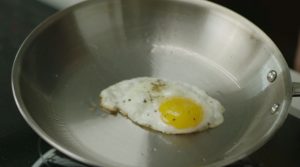
Both the Heritage Steel Titanium and Eater pans performed well in our testing. We were able to make eggs, fish, burgers, chicken breasts, and even sear steaks, all with excellent results.
We tested the heat conductivity and heat retention by boiling water in the skillet and measuring how long it took to come to a boil as well as how long it took for the water to cool. These tests aren't completely scientific--more of an observation--so we won't share the "data" we found. Suffice to say that the Heritage Steel Titanium skillet heats quickly and evenly and is a joy to use. The heat retention is slightly longer than All-Clad's D3 skillet by almost a minute.
The Eater skillet also heated quickly and evenly and had a heat retention about 30 seconds longer than the All-Clad D3 skillet.
Overall, cooks should be delighted with the performance of Heritage Steel cookware.
Durability
Durability means that cookware will stand up to use and abuse in the kitchen--high heat, cooking oil, dishwashers, metal utensils, and more--and last for decades without losing any of its features.
Most cooks value durability and want cookware that will last for a long time.
Clad stainless cookware is one of the most durable types of cookware on the market. You have to buy wisely because the quality of steel can vary, particularly among less expensive brands, and too-thin pans can warp if heated or cooled too quickly. If you buy a good brand of clad stainless cookware--like Heritage Steel--it should last for several decades.
Safety and Stability (Non-Reactivity)
Of course, safety is the most important concern when buying cookware. We list it third only because you can assume that any cookware we test and recommend is a safe choice.
When we look at safety, what we're really looking at is stability, or non-reactivity. Stability means that the cooking surface is non-reactive and won't rust, corrode, affect the flavor of food, or--most importantly--leach toxins.
Stainless steel will leach tiny amounts of nickel, chromium, and iron. None of these are toxic to people, particularly in the minute amounts released by stainless steel cookware. And over time, as the stainless cookware is used, the amounts of leaching become less and less, until there's little to no leaching at all.
Nearly all types of cookware leach some chemicals, but stainless steel is one of the safest, most stable materials you can choose. Nickel, chromium, and iron are all needed in the human body, so they are only an issue if a person has an allergy or a rare disease that makes them sensitive to iron.
Heritage Steel's 316Ti steel is more corrosion resistant than the 304 steel, particularly when it comes to salt, but it has the same nickel and chromium content as 304 and is likely to leach them at an equal rate (i.e., very little, and none in amounts that are unsafe).
For more information, see our Guide to Safe, Non-Toxic Cookware.
Design
This section discusses features that affect your daily use experience, including pan shape, handle shape, weight, lids, and ease of cleaning.
Note that "good" vs. "bad" design is mostly personal preference. What one person loves someone else might hate. It's important to look at as many features as possible before buying because cookware can be good quality, but wrong for you.
Pan Shape: Skillets
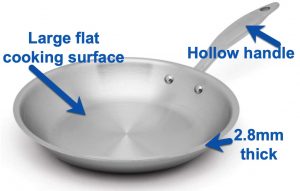
Heritage Steel skillets have a good basic shape. The sides are a little more sloped than we like, resulting in a smaller flat cooking surface than some other brands have (about 9 inches of flat surface on the 12-inch skillet in both the Titanium and Eater lines). This is a small complaint, though, as the pans have a basic shape you'll find on most brands of skillets.
We love that Heritage Steel skillets are thicker than their sauce pans and stock pots (which don't need the thicker heating core and extra weight). At 2.8mm thick, they are 0.2mm thicker than All-Clad skillets. This may not sound like a lot but the result is better thermal conductivity as well as better heat retention.
Our testing proved this: both the Heritage Steel Titanium and Eater skillets heated more evenly than All-Clad D3 and held onto heat longer (as shown in the boiling water test).
These differences may seem small, but in daily cooking you will appreciate the better performance.
Pan Shape: Sauce Pans and Sauciérs
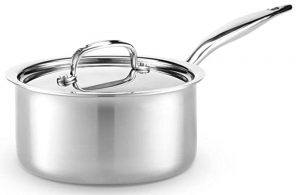
Heritage Steel Titanium 3-quart sauce pan.

Heritage Steel Titanium 3-quart sauciér.
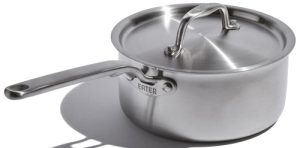
Heritage Steel Eater sauce pan (note different handles).
You can use sauce pans and sauciérs interchangeably, but sauce pans are better for cooking liquids like making soup or boiling pasta, and sauciérs are designed for making sauces that require whisking and reducing.
Heritage Steel sauce pans and sauciérs both have a pretty standard shape: the sauce pans have straight sides, while the sauciérs have curved bottoms for ease of whisking. The sauciér has shallower sides which helps with reducing sauces; the sauce pans are deeper, which is good for cooking liquids (less sloshing and fewer spills).
Because of the lower sides of the sauciér, we recommend the sauce pan for general use. You should get a sauciér only if you frequently make sauces that require whisking and reduction (e.g., bechamel, hollandaise, caramels, etc.).
Handles and Helper Handles

Heritage Steel Titanium skillet handle.
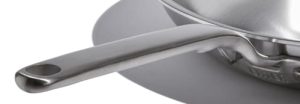
Heritage Steel Eater skillet handle.
The handles on Heritage Steel Titanium cookware are decent, but not our favorites: the long handles are hollow, which helps keep them cool to the touch and keeps them a bit lighter. The handle rises just slightly above the top of the pan and provides good leverage (not too high and not too low). However, the bottom of the handle is rounded, which can make it difficult to stabilize, especially if your hands are wet.
The handles on the Eater Series are better. They're flatter on the top and the bottom, so they're easier to grip and use to stabilize a pan. The Eater handle is a definite improvement over the Titanium handle.
On larger Heritage Steel pieces--anything larger than 3 quarts--they use two short handles. This makes their large pots and pans easier to handle. Short handles on both series are similar:
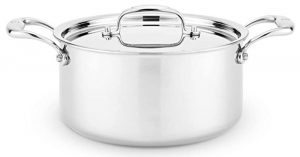
Titanium Series stock pot.
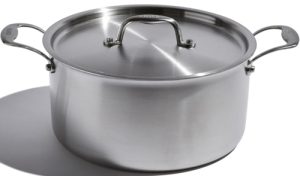
Eater Series stock pot.
Helper handles are small handles opposite the long handle to help you maneuver a full, heavy pan:

Helper handles are typically found on larger pieces (4 quart sauce pans, 12-inch skillet, and on most sauté pans).
Unfortunately, neither Heritage Steel 12-inch skillet has a helper handle. This is a big pan that would benefit from a helper handle. Since this is a safety issue, we consider it a drawback, especially since the Titanium 12-inch skillet is about half a pound heavier than the All-Clad D3 12-inch skillet (which does have a helper handle).
Weight
As we said, you should buy the heaviest cookware you can comfortably handle. Heavy cookware heats better and lasts longer than light cookware.
This is especially true for clad stainless skillets, which need a thick layer(s) of aluminum to perform well and be resistant to warping.
Heritage Steel's skillets are thicker (2.8mm) than All-Clad D3 and D5 (2.6mm) and are therefore heavier. To compare, the 12-inch Heritage Steel Titanium skillet weighs just over 3 pounds (49 ounces), and the Eater 12-inch skillet weighs 2.9 pounds (46 ounces). The All-Clad D3 12-inch skillet weighs 2 pounds, 11 ounces (43 ounces). All of these weights are without lids.
These aren't huge differences, and may not affect your buying decision, but the greater thickness and weight of the Heritage Steel skillets will result in more even heating and better heat retention, as well as increased durability.
Heritage Steel sauce pans and stock pots are thinner than the skillets. These pieces don't require the thicker heating core that a skillet does, so Heritage Steel uses a thinner steel (2.3mm). This makes them lighter than other brands' sauce pans and stock pots of the same size.
Lids
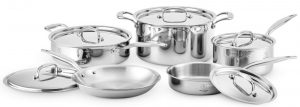
Heritage Steel Titanium 10pc set: all flat lids.
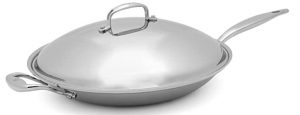
Heritage Steel French skillet: domed lid.
All Heritage Steel lids are stainless steel, which we prefer to glass (it's lighter, more durable, and tends to be a mark of higher end cookware). Heritage Steel manufactures their lids in the USA, unlike All-Clad, which now imports them from China.
Most Heritage Steel lids are flat, but a few Titanium pieces have domed lids. Domed lids offer more room, but they also take up more storage space, so be sure you want the domed lids before buying those pieces.
As shown in the images above, all pieces in the Titanium cookware sets have flat lids, but the more specialized pieces such as the French skillet and wok have domed lids.
All the pieces in the Eater line have flat lids.
Ease of Cleaning
Ease of cleaning is a nice feature in cookware, and is the only reason nonstick cookware is so popular. However, all cookware is easy to clean if you know the right cooking techniques.
Clad stainless cookware has a reputation for being sticky and hard to clean. But that's only because people aren't using the right cooking methods. If you follow a few simple rules, stainless steel cookware is pretty easy to clean.
How to keep stainless steel cookware easy to clean: Use low heat (no higher than medium), heat the cooking oil before adding food, then allow food to release naturally before attempting to move it. Doing this will help keep your stainless pans easy to clean.
The Heritage Steel website has a page on stainless cooking techniques to help you learn how to cook with your stainless pan without sticking.
You can also use a method called the Leidenfrost Effect, a temperature-dependent "trick" that allows you to cook on stainless even without oil and have the pan remain nonstick.
Free yourself of the notion that you have to use nonstick cookware if you hate washing dishes. It's simply not true. Once you understand how to use stainless steel, you'll never need another nonstick pan
(not even for eggs).
Value
Rather than just looking at cost, we look at cost-per-year-of-use. So for example, if you spend $100 on a set of cookware that lasts for 5 years, you are paying $25 per year of use (a common scenario for nonstick cookware).
If you spend $500 on a set of cookware that lasts for 30 years, you are paying about $16.60 per year of use. For clad stainless cookware with a lifetime warranty, 30 years is a low estimate of how long it will last.
Heritage Steel cookware is a high-end brand. It competes with All-Clad, Viking, and Demeyere (links go to our reviews). It is not low budget cookware by any means--but its cost-per-year-of-use is low because it lasts a lifetime.
If you have the budget for good quality cookware, Heritage Steel (both lines) should be on your short list.
Heritage Steel has a lifetime warranty against manufacturing defects. They will replace defective pieces free of charge.
see heritage steel cookware at amazon
see heritage steel cookware at heritage steel site
Heritage Steel Vs.All-Clad

Heritage Steel Eater skillet.

All-Clad D3 skillet.
How does Heritage Steel stack up to All-Clad? Let's find out.
Price: If you compare Heritage Steel to All-Clad, set prices are similar; a 10-piece set of Heritage Steel Titanium goes for about the same as a 10-piece set of All-Clad D5 (and Heritage Steel will heat faster and more evenly than D5). The 10-piece set of Heritage Steel x Eater is about the same or slightly less than a 10-piece set of All-Clad D3.
Prices on individual pieces can vary quite a bit, as this chart shows:
Heritage Steel Item and App. Price | All-Clad Item and App. Price |
|---|---|
Titanium 10.5-inch skillet: $80/$130 w/lid Eater 10.5-inch skillet: $90 (no lid) | D3 10-inch skillet: $130/$99 w/lid D5 10-inch skillet: $180 (no lid) |
Titanium 12-inch skillet: $100 (no lid) Eater 12-inch skillet: $100 (no lid) | D3 12-inch skillet: $190/$122 w/lid D5 12-inch skillet: $180 |
Titanium 3-quart sauce pan: $160 Eater 3-quart sauce pan: $130 | D3 3-quart sauce pan: $120 D5 3-quart sauce pan: $140 |
Titanium 8-quart stock pot: $280 Eater 8-quart stock pot: $200 | D3 8-quart stock pot: $365 D5 8-quart stock pot: $400 |
For more information, see our article All-Clad D3 Vs. D5: Which Is Better?
Country of Origin: Both All-Clad and Heritage Steel cookware are made in the USA. However, All-Clad makes only their clad stainless pieces in the US. Everything else is now made in China. This includes nonstick cookware, appliances, utensils, and the stainless steel lids for their clad stainless cookware. In fact, All-Clad is even making some of their stainless cookware in China now, such as this disc-clad stock pot.
Heritage Steel makes all their cookware in the USA, including lids. Some of their raw materials may be purchased overseas, including the steel, but all the cookware is designed and assembled here, including lids.
If country-of-origin is important to you and you want to buy American-made products, Heritage Steel wins over All-Clad.
Overall Quality: All-Clad is top notch cookware and will last a lifetime, so it's hard to say Heritage Steel is even better. However, the 316Ti stainless on the Titanium series as well and the 439 magnetic stainless on both the Titanium and Eater series are both more corrosion resistant than the 304 (18/10) and 430 steels used on All-Clad. Both companies make highly durable cookware, Heritage Steel slightly edges out All-Clad in this category.
We like that the Heritage Steel Titanium pans are made in different thicknesses so you get a heavy pan where you need it (skillet) and lighter cookware where you don't need it (sauce pans and stock pots). Only a few cookware makers do this, and those that do tend to have put a lot of thought into design and functionality.
We can't say that Heritage Steel is better than All-Clad, but it is certainly as good as All-Clad. It all depends on what you're looking for.
Heritage Steel Vs. Made In

Heritage Steel Eater skillet.
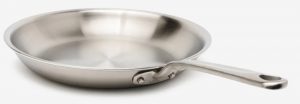
Made In skillet.
Made In is good quality clad stainless steel cookware, and it ranks right up there with All-Clad and Heritage Steel. Made In was originally marketed as a cheaper high quality alternative to All-Clad, but prices have crept up over the years, so it's no longer automatically the most affordable choice. (In fact, if you want affordable, we recommend Tramontina Tri-Ply Clad or Cuisinart Multiclad Pro.)
The Heritage Steel Titanium line is a higher quality than Made In because of the 316Ti steel and the variable pan thicknesses (skillets are thicker than sauce pans and stock pots in the Heritage Steel lines). The Heritage Steel x Eater line is comparable to Made In, so we recommend going with whichever brand you prefer, or has the best prices.
For more information, see our Made In Vs. Misen article. (We prefer Misen to Made In because it has a thicker heating core, even slightly thicker than Heritage Steel, so Misen is a good choice quality-wise and also affordable.)
Heritage Steel Titanium Vs.Saladmaster
If you compare Heritage Steel Titanium to Saladmaster, another cookware brand that uses 316Ti for the cooking surface, Heritage Steel costs a fraction of Saladmaster. Yet the 316Ti cooking surface on Heritage Steel Titanium provides an identical cooking experience.
(Saladmaster fans may disagree, but our testing shows this to be true.)
Also, we prefer the stainless handles on Heritage Steel to Saladmaster's plastic handles. They'll last longer and they look better.
Saladmaster's direct marketing--you have to buy through a rep who comes to your house and gives a demonstration, which makes it harder to compare to other brands--is off-putting to some people (including us).
read more in our saladmaster review
Heritage Steel Cookware Pros and Cons
Pros
Cons
*We did not have either of these issues in the pans we tested.
Heritage Steel Titanium Series Buying Options
Heritage Steel has a number of good buying options, including sets and open stock (individual) pieces.
If you're looking for a set, we recommend the 8 piece core set: all usable pieces and nothing you don't need.
Titanium 5 Piece Essentials Set ($480)

See 5 Piece Essentials Set on Amazon
See 5 Piece Essentials Set at Heritage Steel
About $480
The 5 piece Essentials set includes:
- 10.5-inch skillet
- 3-quart sauce pan with lid
- 4-quart sauté pan with lid.
These are all useful pieces. The 10.5-inch skillet is average, but the 3-quart sauce pan and 4-quart sauté are both excellent. The sauté pan lid will fit the 10-inch skillet.
see heritage steel Titanium 5 Piece Essentials set:
*Titanium 8 Piece Core Set ($800--Recommended)
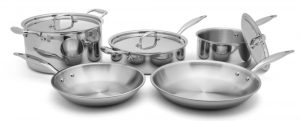
See 8 Piece Core Set on Amazon
See 8 Piece Core Set at Heritage Steel
About $800
The 8 piece Core set includes:
- 10.5-inch skillet
- 12-inch skillet
- 3-quart sauce pan with lid
- 4-quart sauté pan with lid
- 8-quart stock pot with lid.
We love that this set has a 12-inch skillet. Most cookware sets include 8-in and 10-in skillets and you have to buy their giant sets to get the 12-inch, or buy it separately. This big skillet is infinitely more useful (for most cooks) than the tiny 8-inch pan, especially if you are cooking for more than two people, entertain often, or do meal prepping.
This 8 piece Core set is our favorite and the one we recommend: it has excellent pieces that most cooks will love, in (we think) better sizes than you'll find in the 7-piece or 10-piece sets from All-Clad.
One complaint is that there is no lid in the set that will fit the 12-inch skillet, and as far as we can tell, Heritage Steel does not make one. So if you need a lid for the large skillet, you'll have to buy one separately.
see heritage steel Titanium 8 piece core set (recommended!):
Titanium 10 Piece Set ($900)

See the 10 Piece set on Amazon
See the 10 piece set at Heritage Steel
About $900
The 10 piece set includes:
- 10.5-inch skillet with lid
- 1.5-quart sauté pan with lid
- 3-quart sauce pan with lid
- 4-quart sauté pan with lid
- 8-quart stock pot with lid.
This set has only one skillet, and we love that it comes with a lid, but one skillet--especially a mid-sized one--may not be enough for most cooks (most cookware sets this size come with two skillets).
Also, the 1.5-quart sauté pan is small, and you'll probably use it more like a tiny sauce pan than a sauté pan.
The 4-quart sauté pan is a great piece, which you can use as another skillet if you need to. But most cooks need at least two skillets in different sizes and at least two sauce pans in different sizes. It's a little odd that this set has two sauté pans, but only one skillet and one sauce pan.
see heritage steel Titanium 10 piece set:
Titanium 14 Piece Gourmand Set ($1500)
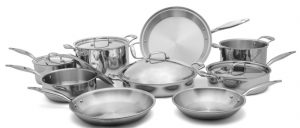
See 14 piece Gourmand set at Heritage Steel
About $1500
The 14 piece set includes:
- 3-quart sauce pan with lid
- 3-quart saucier with lid
- 10.5-inch skillet
- 12-inch skillet
- 4-quart sauté pan with lid
- 5-quart sauce pot
- 8-quart stock pot with lid
- 8-quart rondeau with lid
- 13.5-inch paella pan.
This is a huge set, and you may not use all these pieces. The 5-quart sauce pot and paella pan should have lids and don't (though some of the other lids will fit, as shown in the photo). The two large skillets are nice, and the 8-quart rondeau is a great piece.
see heritage steel Titanium 14 piece gourmand set:
Open Stock (Individual Pieces)
See Heritage Steel pieces on Amazon
See Heritage Steel pieces at Heritage Steel
Heritage Steel has a good selection of open stock pieces available, including all the pieces you'll find in their sets plus many other pieces like sauciérs, stock pots, woks, roundeaus, deep sauté pans (an excellent piece!), and sauteuses.
You can see the entire collection at Heritage Steel, though pieces are often sold out. You will find better prices (usually) on Amazon: even though not all the pieces show up on the main Amazon page (the link above), most of them are listed on individual pages--so most of the pieces are on Amazon, you just have to drill down for them.
For example, if you want the sauciér, click over to the sauce pan page. If you want the 8-quart family sauté pan (an excellent piece!), click over to the sauté pan page; this page also has the sauteuses and rondeaus (which are essentially short-handles sauté pans in various sizes).
See all heritage steel Titanium Series pieces:
Heritage Steel Eater Series Buying Options
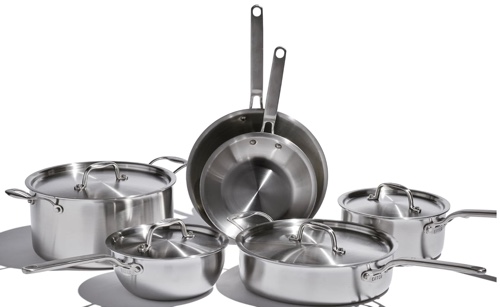
Here are the buying options for the Heritage Steel Eater Series.
Sets: 5 Piece, 8 Piece, 10 Piece
See All Sets at Heritage Steel
5 piece set about $330
8 piece set about $550
10 piece set about $650
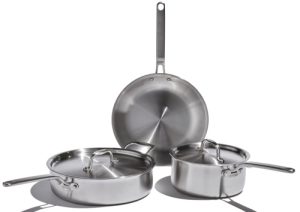
The 5 Piece set:
-10.5 inch skillet
-3 qt sauce pan w/lid
-4 qt sauté pan w/lid.

The 8 piece set:
-10.5/12 in. skillets
-3 qt sauce pan w/lid
-4 qt sauté pan w/lid
-8 qt stock pot w/lid.
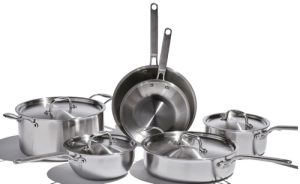
The 10 piece set:
-8.5/10.5 in. skillets
-2 qt sauciér pan w/lid
-3 qt sauce pan w/lid
-4 qt sauté pan w/lid
-8 qt stock pot w/lid.
As with the Titanium Series, we recommend the 8 piece set: It has two large skillets--10.5 and 12 inch--while the 10 piece set has a small skillet (8.5 and 10.5"). You'll get a ton of use out of the 3 quart sauce pan and large stock pot.
The 5 piece set is alright, but most people will also want a stock pot. We would like the 10 piece set if it had two large skillets. The 2-quart sauciér is a nice piece, but the sauce pan is probably the more usable piece for most cooks.
All of the pieces are functional and there's nothing you won't use (like a too-tiny sauce pan). But overall, the 8-piece set has the most versatile and functional pieces.
buy heritage steel eater series cookware sets:
Eater Series Open Stock (Individual Pieces)
The Eater Series has fewer open stock options than the Titanium Series, but it does have all the basics.
We like the Eater Series for its brushed exterior and flatter handles. The cooking performance will be about the same as the Titanium Series, with a slightly different appearance.
Skillets

About $80-$90-$100
See Eater skillets at Heritage Steel: 8.5 inch - 10.5 inch - 12 inch
Shallow skillet with good handle. Great for an all-purpose frying pan.
3 Qt. Sauce Pan w/Lid

About $130
See Eater sauce pan at Heritage Steel
The ideal size for a sauce pan, not too shallow or too deep. Handle fits snugly, handle is comfortable. All in all a well designed sauce pan.
4 Qt. Sauté Pan w/Lid
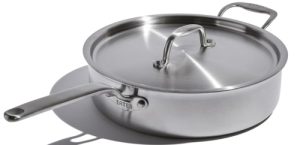
About $150
See Eater sauté pan at Heritage Steel
This is approximately equivalent to a 10-inch skillet, but the straight sides provide more flat cooking surface. This is a great all-purpose pan.
2 Qt. Saucier Pan w/Lid

About $120
See Eater sauciér at Heritage Steel
The ideal size for a sauciér. You can use this 2-quart pan as a standard sauce pan or make delicate sauces. The rounded bottom means a whisk can reach the whole pan surface.
8 Qt. Stock Pot w/Lid

About $200
See stock pot at Heritage Steel
Some people prefer a 6 quart stock pot, but an 8 quart is better for actual stock making. If you want a smaller size for braising, we recommend a 5.5-6 quart enameled Dutch oven.
buy heritage steel eater series open stock pieces:
Heritage Steel Cookware FAQs
Here are some common questions about Heritage Steel cookware.
Is Heritage Steel Cookware Good Quality?
Yes, both Heritage Steel lines (Titanium and Eater) are good quality cookware made in the USA.
Is Heritage Steel Cookware Induction Compatible?
Yes, all Heritage Steel cookware is induction compatible.
Is Heritage Steel Cookware Dishwasher Safe?
Yes, Heritage Steel cookware is dishwasher safe.
What's the Difference Between the Titanium Series and the Eater Series?
The Titanium Series has 316Ti stainless steel for the cooking surface and the Eater Series uses 304 stainless steel for the cooking surface. Both use 439 magnetic stainless for the exterior.
Also, there are more pieces available in the Titanium Series, including rondeaus, paella pans, and more. The Eater Series has just basic pieces like skillets, a sauce pan, a sauté pan, and a stock pot. All Eater Series pans have flat lids, while some of the Titanium Series pans have domed lids.
Is Heritage Steel Cookware as Good as All-Clad?
Yes, Heritage Steel cookware is as good as All-Clad. The 316Ti steel on the Titanium Series is more corrosion resistant than the 304 steel used on All-Clad.
Where Is Heritage Steel Cookware Made?
All Heritage Steel cookware is made in the USA, but some of the raw materials are sourced overseas.
Final Thoughts and Recommendations
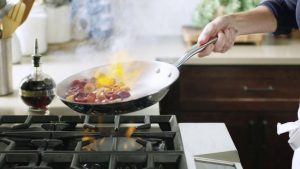
We hope this Heritage Steel cookware review was helpful. Heritage Steel is an American company that makes all their cookware in the USA. They make two series, Titanium and Eater. The quality is excellent and they have several good buying options as well as a large variety of open stock (individual) pieces. The Titanium Series uses higher quality stainless steel than that found on most other brands, including All-Clad; the Eater Series uses the same steel as All-Clad.
Our favorite set is the 8 piece Core set in either the Titanium or Eater Series. It has two large skillets and other great, functional pieces.
Overall, we like Heritage Steel and recommend it.
Thanks for reading our Heritage Steel review!
If you found this article helpful, please share:
